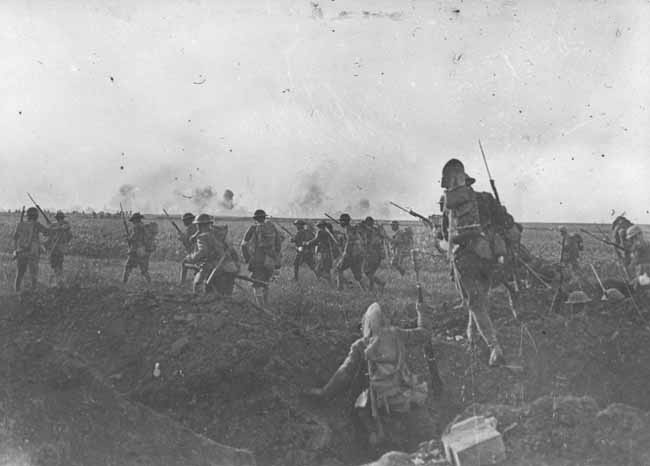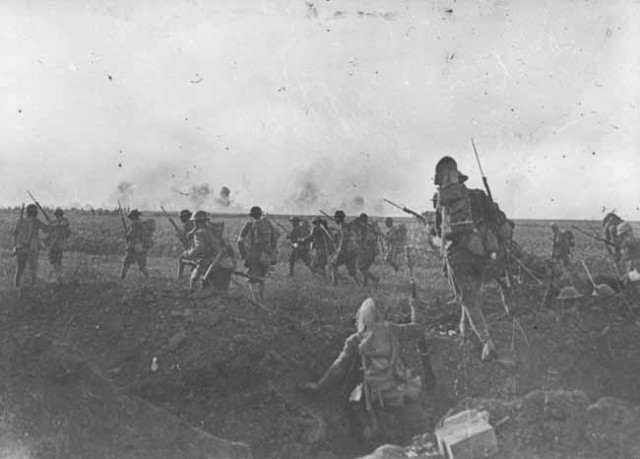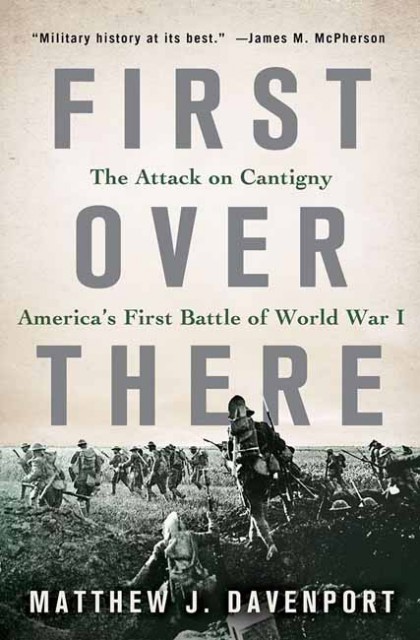As we continue through the centennial of the First World War, the body of literature on the subject continues to grow. Among the most recent additions to this body is Matthew J. Davenport’s First Over There: The Attack on Cantigny, America’s First Battle of World War I. An in-depth account of an often overlooked, but critical moment in World War I, this book is certain to become the “go to” for those interested in the Battle of Cantigny. When the boys of the U.S. Army’s 1st Division went “over the top” to attack German forces in the early morning of May 28th, 1918, events were set in motion that would catapult the U.S. to a new place upon the world stage. The assault on the French hilltop village was the first time American tanks, aircraft, and modern artillery worked in concert in battle. With the hard-fought victory at the Battle of Cantigny came the birth of the modern American Army.
Davenport’s monograph is first rate. To begin with, it is very well written, and his narrative style is engaging. The book is littered with anecdotal accounts drawn from letters, diaries, and other primary source material. Readers come away with a real feel for the characters in this book, from the dignified and aloof General John “Black Jack” Pershing, to the unpretentious commander of the 1st Division, General Robert Bullard, to the “incarnation of the Christian solider,” Lt. George Redwood, who promised to read the Bible to enemy prisoners. Redwood is a particularly fascinating fellow—a scout so skilled at patrolling that he was known to “slip into enemy trenches in the dark, grab material—sometimes even snatching their rations and coffee—then slip back out without notice.” Capable of speaking German “like a Hun,” Redwood was reported to even hold conversations with enemy soldiers, who in the dark of night, believed him to be one of their own. Accounts like this fill the book, helping to bring the battle to life. At every turn of the page, readers are introduced to soldiers from a wide range of American locales, such as Arthur Cunningham of Clinton, Indiana, or Jeremiah Evarts of Windsor, Vermont. This makes the content relatable, not to mention it is sure to be of interest to local historians in these areas.
The horrors of war are described in the most realistic of ways. “Death became a daily spectacle,” as men were buried alive in their trenches, killed instantly from shell bursts, or suffered a slow and agonizing death resulting from gunshot wounds or poison gas attacks. As one officer noted: “I have seen my entire platoon… disappear off the face of the earth… and in less time than it takes to tell.” During the battle an average of 3,400 shells were fired into the American sector each day—that works out to two each minute. The weaponry and tactics involved in the battle are also addressed. The water-cooled Maxim machine gun used by the Germans was a devastingly effective weapon, and was used with great success to defend entrenched positions. Artillery tactics, not surprisingly, occupies a central role in this book. Davenport describes the different sizes and types of shells, and how they were used.
Not only did the boys of the 1st Division have to attack and capture the strategic village of Cantigny, they also had to hold it against a bitter German counter-attack. When the fighting ceased, the 1st Division’s casualties numbered over 1,300 men. Although this is a relatively small number compared with other battles (think about the Somme or Verdun, for example), Davenport points out that “the scale of turning points is not always grand.” A pivotal moment in the war, Cantigny was the doughboy’s baptism by fire. It was the Americans first clash with the Germans, and it set the stage for all future engagements. Not only that but, Davenport describes the battle as the “U.S. military’s coming of age”—a moment when it “crossed a historical no-man’s land that separated contemporary fighting methods from the muskets and cannon of the nineteenth century.”
First Over There is a solid, comprehensive account of America’s first battle of World War I. Davenport’s stated aim is “to accurately tell the story of the men who fought the Battle of Cantigny…” He succeeds in this aim, and has constructed a history that is as gritty as it is engaging. To his credit, Davenport also does an excellent job of weaving in the broader context of American involvement in World War I. While much of the book focuses on anecdotal accounts of “little men,” i.e. captains, lieutenants, etc., the “great men” (like George C. Marshall and Woodrow Wilson) are not neglected either. Ordinary trench life is depicted alongside broader geo-political developments. See, this is a well-balanced book on a variety of levels. First Over There is drawn heavily from primary source material and thoroughly researched. Maps are included, and unlike some military histories, are relatively easy to interpret. Davenport should be congratulated on his first book. Hopefully he will produce more.
Reviewed by Nate Sullivan for War History Online
First Over There: The Attack on Cantigny, America’s First Battle of World War I
By Matthew J. Davenport
Thomas Dunn Books, an Imprint of St. Martin’s Press
ISBN: 978-1-250-05644-3


